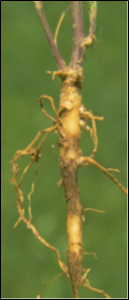Phytophthora Root Rot in Alfalfa
Phytophthora Root Rot
Symptoms
Stands are stunted and thin in Phytophthora-infected areas. Leaves on severely affected plants turn yellow or tan and drop early. Regrowth is slow after harvest.

Phytophthora Root Rot
Dig (do not pull) surviving plants and look for reddish-brown rotted areas on roots that may extend to the crown. Affected areas of roots later turn black in color. Eventually a severely affected tap root becomes rotted off. Affected plants sometimes show reddening typical of phosphorus deficiency. This disease also causes damping off of seedlings.
Cause
Cool, wet periods of weather combined with heavy, poorly drained soils (especially soil with high clay content) are most favorable for Phytophthora development. Excessive rainfall or soil compaction can increase the root rot problem. Look in waterlogged areas for the disease. This disease can cause great seedling loss. The preferred name of the causal agent is Phytophthora medicaginis, but it is also reported as Phytophthora megasperma f. sp. medicaginis.
IPM Techniques
- Examine plants in the field every four weeks from April 15 until September 15. Examine any suspicious-looking plants within 100 feet of the monitoring site. Report the severity of the disease according to the following rating scale:
0 = no infected plants, good healthy stand
1 = one plant has symptoms, appearance of some missing plants in stand
2 = from 2 to 10% of plants infected, several; areas where stand slightly thinned;
3 = more than 10% of plants infected, severe thinning of stands.
- The most important control measures for Phytophthora root rot are resistant varieties and soil and water management.
- Grow only varieties with at least moderate resistance to Phytophthora root rot. Use varieties with higher resistance levels in fields where the disease has been diagnosed.
- Use metalaxyl-treated seed.
- Use deep tillage to break up compacted soil horizons.
- Crop rotation helps to reduce inoculum levels, but long-term rotations are necessary to eradicate the fungus.
References And Additional Information
- IPM-1 Kentucky Alfalfa IPM Manual
- PPA-10d Kentucky Plant Disease Management Guide for Forage Legumes, P. Vincelli, Extension Plant Pathology, University of Kentucky
- ID-104 Managing Diseases of Alfalfa, P. Vincelli, Extension Plant Pathology, and G.D. Lacefield and J.C. Henning, Agronomy, University of Kentucky
- Compendium of Alfalfa Diseases. 2nd ed. Stuteville, D.L. & D.C. Erwin, (eds.). 1990.
- Annual Kentucky Alfalfa Variety Test Report, Progress Report 351, University of Kentucky


